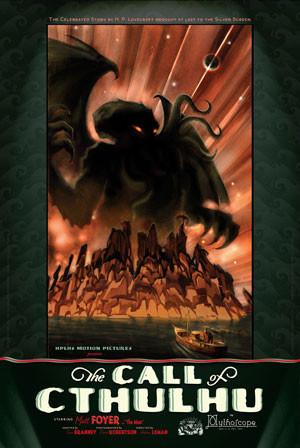 One of the more unique films made from the writings of H.P. Lovecraft, a silent movie based on one of the maestro’s most famous stories. THE CALL OF CTHULHU is a reverent and sincere effort with much to admire, but I’m ultimately not too enthusiastic about it—for all the skill and imagination with which it was put together, it’s something of a missed opportunity.
One of the more unique films made from the writings of H.P. Lovecraft, a silent movie based on one of the maestro’s most famous stories. THE CALL OF CTHULHU is a reverent and sincere effort with much to admire, but I’m ultimately not too enthusiastic about it—for all the skill and imagination with which it was put together, it’s something of a missed opportunity.
“The Call of Cthulhu” was the first story in H.P. Lovecraft’s Cthulhu Mythos cycle, which remains the author’s most famous work. It introduced the dread Cthulhu, a tentacled monstrosity who once lorded over the planet but eventually lost power when his center of operations, the city of R’yleh, sank beneath the ocean. But Cthulhu still lives on in dreams, and through followers who chant “Ph-nglui mglw’nafh Cthulhu R’yleh wgah’nagl ftagn” (“In his house at R’yleh dead Cthulhu waits dreaming”). The tale ends in a rousing bit of action, with a group of clueless sailors stumbling upon the submerged city of R’yleh and getting pursued by the Big C.
The story has long been thought to be unfilmable, but that didn’t stop the folks at the H.P. Lovecraft Historical Society, who had previously put on several Lovecraft-inspired stage comedies, from attempting it. The resulting 47-minute film was done as a black-and-white silent movie (which makes sense considering the story was initially published back in 1926, when silent cinema was still in vogue). It took nearly two years to complete, was an official selection at the 2006 Sundance Film Festival, and is now available on DVD from www.cthulhulives.org.
A madman interned in an insane asylum recounts for a psychiatrist the horrific events that led to his current state. It all began, he claims, with the death of his uncle. The latter, a University Professor, was an authority on ancient inscriptions. Going through his deceased relative’s possessions, the protagonist discovers a weird clay sculpture of an unearthly monstrosity. Accompanying the sculpture is a manuscript detailing a cult devoted to something called Cthulhu and the author’s descriptions of strange dreams he experienced involving a scary city.
The protagonist does further research into his uncle’s obsessions and unearths an account by a New Orleans police inspector who witnessed a haunting spectacle one night in a swamp. It seems there were dozens of loin-cloth wearing folks chanting before a large monolith. The chanters were taken into custody, and one of them, an apparent madman, fills the inspector in on what they were up to: they were worshipping Cthulhu, who used to rule the Earth and plans on doing so again. For now, though, Cthulhu resides in the sunken city of R’yleh, waiting and dreaming.
This account is apparently what begun the protagonist’s uncle’s interest in the Cthulhu cult, and the protagonist becomes intrigued himself when he discovers an old newspaper clipping about a mysterious ship whose inhabitants were found in possession of a familiar-looking idol. He springs into action, tracking down the widow of the ship’s now-dead Captain, who lives in Norway and speaks very little English. The woman has little to say, but does produce a document her husband wrote about his doomed voyage (in English so she wouldn’t be able to understand it).
The protagonist wants to throw the manuscript out but can’t contain his curiosity. He reads of how the Captain and his crew came upon the legendary city of R’yleh, somehow raised to the surface of the sea. There they inadvertently unleashed Cthulhu, who promptly chased them into the water. They managed to shake off the monstrosity, but only by ramming it with their ship.
So in the end we’re left with the protagonist in the insane asylum. Cthulhu, he claims, is down but not out, still waiting in his house at R’yleh and still dreaming.
This isn’t a bad film by any means. It’s lively and clever in the way it transposes the nuances of Lovecraft’s convoluted text to the screen in admirably concise fashion, and with a dapper wit that never cheapens or makes fun of the material—an impressive feat considering the tale is goofy in many respects. The silent movie artifice is crucial in this respect, as it allows the story’s details to shine through without an excess of conversation or narration, and the deliberately archaic veneer furthermore excuses (well, almost) the low budget special effects!
My problems with the film are all technical in nature. First and foremost is the fact that it just never feels like a real silent picture. Unlike the films of Guy Maddin, which painstakingly replicate the practices of twenties-era moviemaking, the filmmakers here opted to shoot on video and then digitally added splices and scratches, which never look convincing. Even worse are the wildly distracting digital effects, which are so incongruous they nearly sink the whole enterprise. While on the subject of digital FX, let me add that they’re also incredibly primitive, looking like nothing so much as something created on somebody’s PC, which in all likelihood they were.
Vital Statistics
THE CALL OF CTHULHU
HPLHS Motion Pictures
Director: Andrew Lieman
Producers: Sean Branney, Andrew Lieman
Screenplay: Sean Branney
(Based on the story by H.P. Lovecraft)
Cinematography: David Robertson
Editing: David Robertson
Cast: Matt Foyer, David Mersualt, Jason Owens, John Bolen, Ramon Allen, Jr., Leslie Baldwin, Ralph Lucas, Aidan Branney, Chia Evers, Dan Novy, Jason Peterson, Vivica Prentice, Noah Wagner, Ed Ruffin
